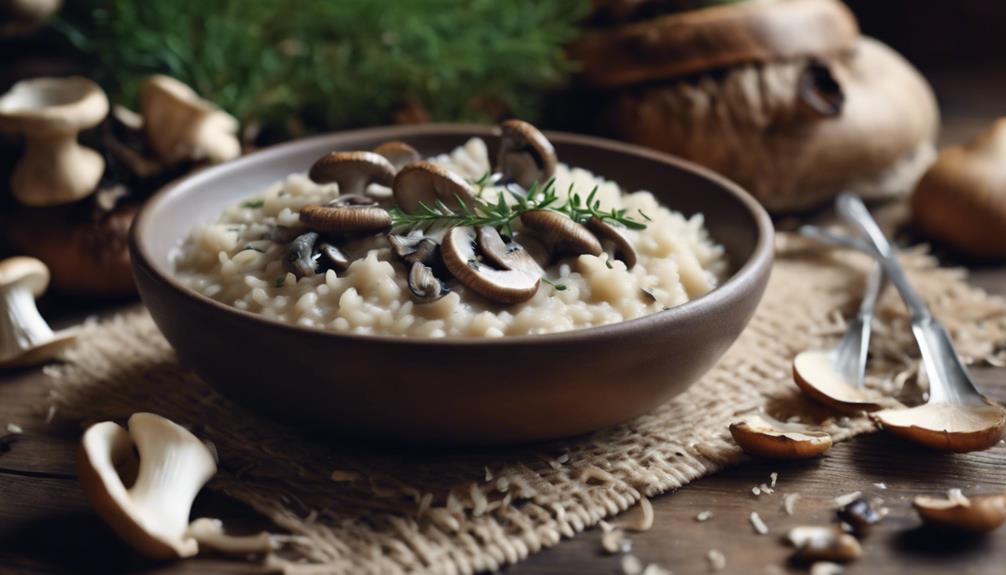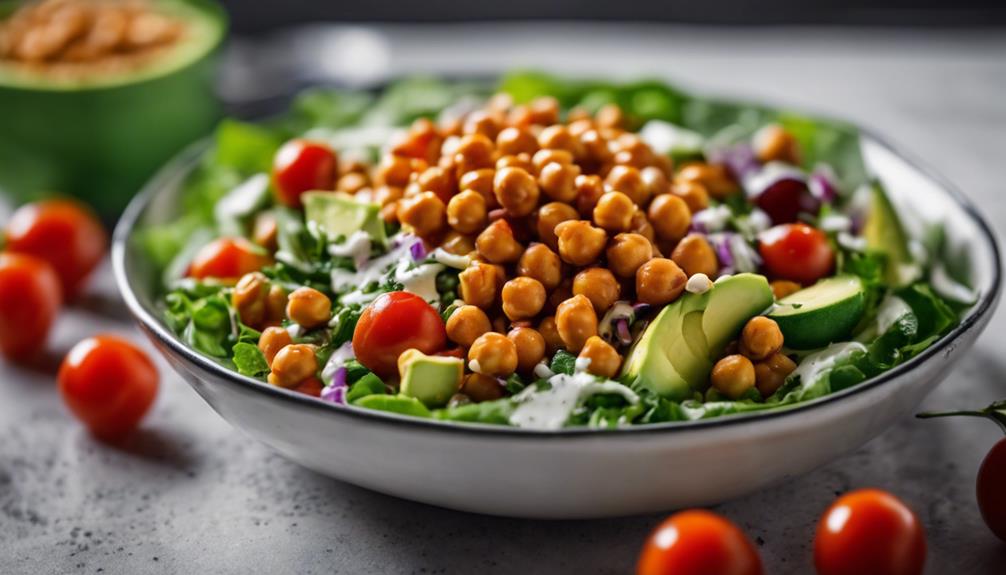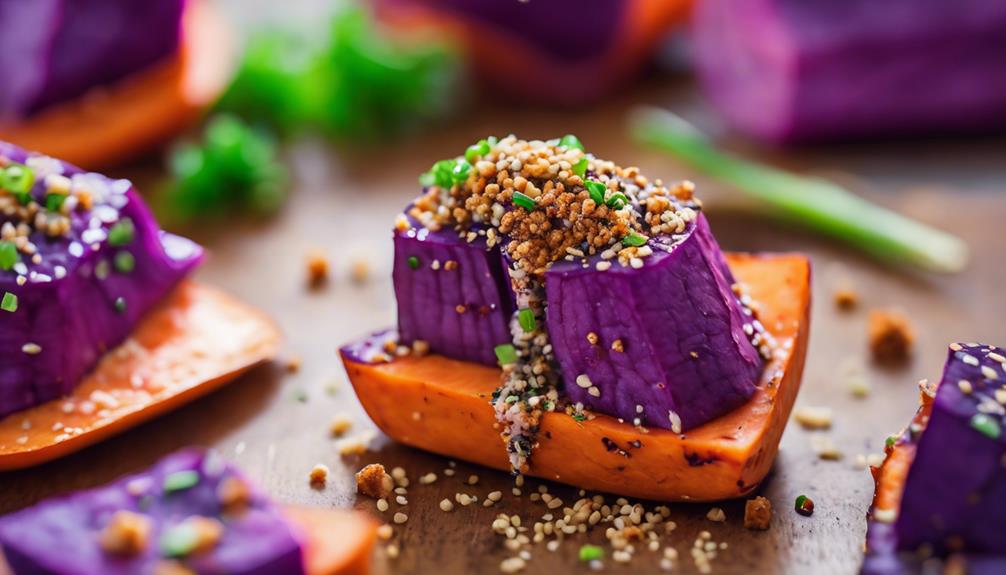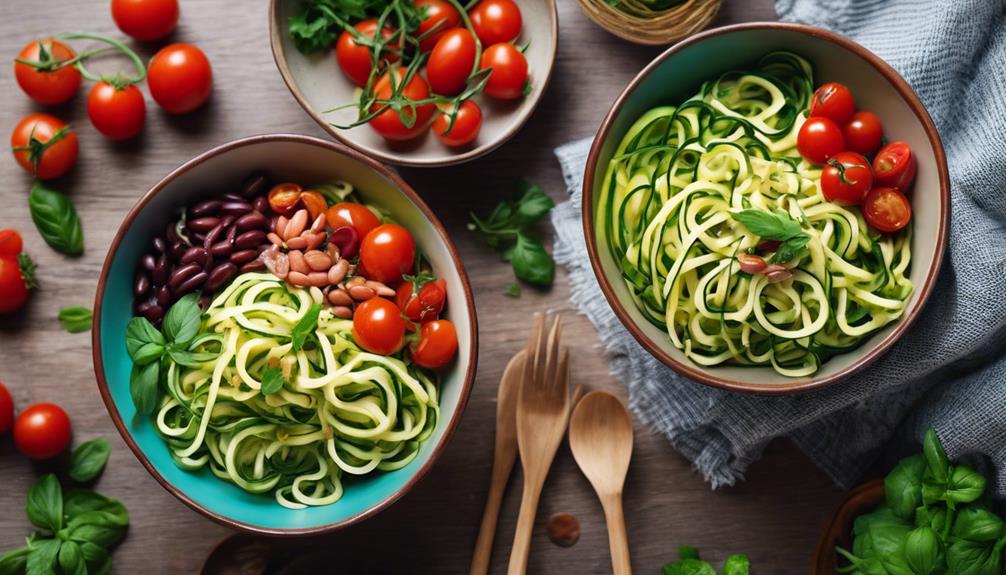Create a healthy turkey vegetable lettuce wrap by combining lean ground turkey, colorful vegetables, and flavorful sauces on crisp butter lettuce. This dish provides a mix of protein, fiber, and essential nutrients. Add mushrooms, water chestnuts, cilantro, and scallions to the wraps for extra flavor and texture. You can store any leftovers in the refrigerator for 3-4 days or freeze the turkey mixture for up to 2 months. Try using Sriracha sauce for a spicy kick. You can also switch out the turkey for chicken or beef while still enjoying the nutritional benefits of butter lettuce. Discover more ways to enhance your meal and have a satisfying dining experience.
Key Takeaways
- Ground turkey provides lean protein for a nutritious meal.
- Butter lettuce leaves offer a crisp base with low calories.
- Incorporating veggies adds fiber, vitamins, and minerals.
- Enhance flavor with soy sauce, hoisin sauce, and ginger.
- Roll turkey and veggie mixture in lettuce leaves for a light, satisfying meal.
Key Ingredients for Turkey Lettuce Wraps
To prepare delicious Turkey Veggie Lettuce Wraps, gather key ingredients such as ground turkey, butter lettuce leaves, and Asian pantry staples like soy sauce and hoisin sauce.
The ground turkey serves as a lean protein option, infusing the lettuce wraps with rich flavor and a satisfying texture. Pairing perfectly with the turkey, the butter lettuce leaves offer a crisp and invigorating base for wrapping the flavorful mixture.
For the sauce, essential components like soy sauce and hoisin sauce bring a savory and slightly sweet taste to the dish. Additionally, adding a hint of ginger can elevate the flavor profile, providing a subtle warmth and depth to the sauce.
These ingredients come together harmoniously to create a mouthwatering filling for the lettuce wraps, ensuring a delightful culinary experience. Whether you choose to stick with traditional ground turkey or explore alternatives like ground chicken or pork, these key ingredients remain fundamental in crafting a delectable and nutritious meal.
Cooking Instructions for Lettuce Wraps

To assemble your lettuce wraps, start by spooning the turkey and vegetable mixture onto each lettuce leaf.
Then, roll the lettuce around the filling, tucking in the ends to secure everything in place.
For variations, consider adding extra toppings like crunchy nuts or a drizzle of tangy sauce for added flavor.
Wrap Assembly Tips
For a successful assembly of the turkey veggie lettuce wraps, begin by carefully selecting large, sturdy lettuce leaves. Follow these tips for a seamless wrap assembly:
- Prep Your Workspace: Lay out all the ingredients and tools you need to assemble the wraps efficiently.
- Place Filling Correctly: Spoon the turkey and vegetable mixture evenly onto the center of each lettuce leaf to guarantee a balanced filling distribution.
- Fold and Tuck: Fold the sides of the lettuce leaf over the filling, then tightly roll from the bottom up, tucking the sides in as you go to create a secure wrap.
- Securing the Wraps: Use toothpicks or wrap them in parchment paper to hold the wraps together, especially if taking them on-the-go.
Filling Variation Ideas
Consider enhancing the turkey veggie lettuce wraps by incorporating additional ingredients like chopped mushrooms, water chestnuts, or broccolini for added texture and flavor.
When sautéing the vegetables, aim for a crisp-tender consistency before introducing garlic and ginger to infuse a burst of aromatic flavors into the mix.
Once the vegetables are ready, reintroduce the cooked ground turkey to the skillet and blend in the sauce, allowing it to thicken and evenly coat all the ingredients.
To finish off the dish, stir in fresh cilantro and green scallions for a vibrant and herbaceous touch that will elevate the overall taste of the lettuce wraps.
These flavorful and light wraps offer a satisfying meal option that's both nutritious and delicious.
For more culinary inspiration and a wide array of mouthwatering recipes, head over to TasteFoodblog.com and explore the diverse selection of flavorful dishes waiting to be discovered.
Nutritional Benefits of Turkey Wraps
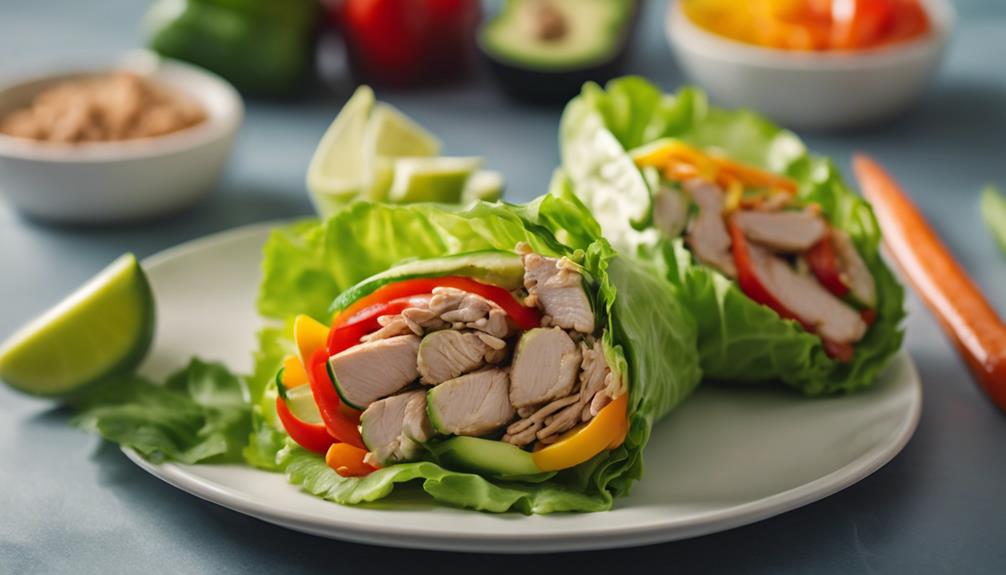
Including turkey wraps in your diet provides numerous nutritional benefits that support your overall health and wellness. Here are four reasons why turkey wraps are a nutritious choice:
- Lean Protein Source: Turkey is low in fat and calories, making it ideal for weight management while still offering essential proteins for muscle growth and repair.
- Light and Invigorating: Lettuce wraps serve as a healthy alternative to bread-based wraps, reducing overall calorie and carbohydrate intake.
- Vegetable Variety: Incorporating colorful vegetables like bell peppers, water chestnuts, and mushrooms into your turkey wraps provides fiber, vitamins, and minerals for added nutritional value.
- Antioxidant Boost: The diverse range of colorful vegetables in turkey lettuce wraps boosts your antioxidant intake, supporting overall health and immunity.
Tips for Prepping Turkey Veggie Filling
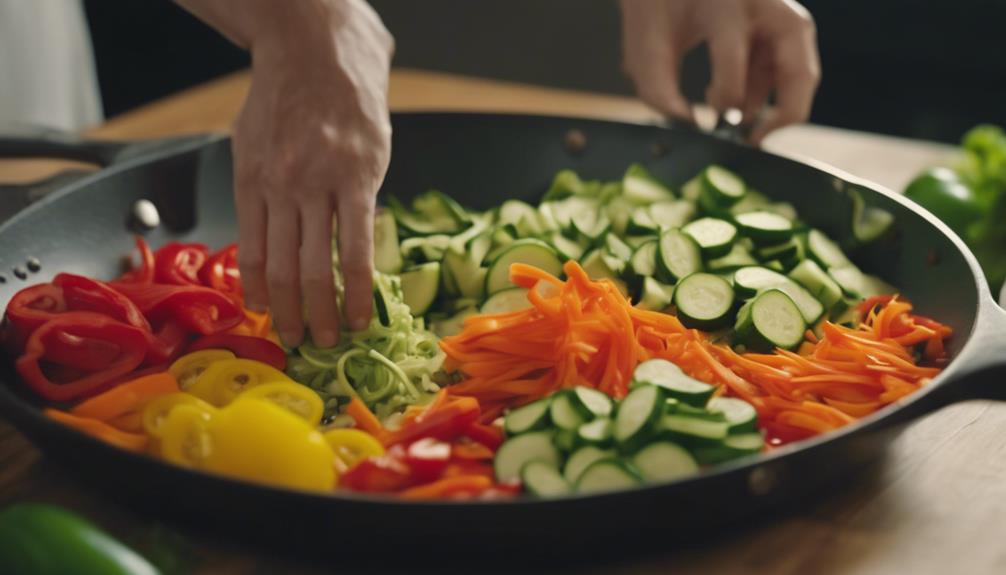
When prepping the turkey veggie filling, make sure you cook the turkey thoroughly to a safe internal temperature.
Chop the vegetables evenly to promote consistent cooking and flavor distribution throughout the filling.
These steps are essential in creating a delicious and well-balanced filling for your Turkey Veggie Lettuce Wraps.
Cooking Turkey Thoroughly
For your turkey veggie filling to be safe to eat, always cook the ground turkey to an internal temperature of 165°F.
Here are some essential tips to make sure your turkey is cooked thoroughly:
- Use a meat thermometer: Insert a meat thermometer into the thickest part of the ground turkey to accurately measure its internal temperature.
- Check for doneness: Cook the ground turkey until it's no longer pink, and the internal temperature reaches 165°F.
- Observe visual cues: Properly cooked turkey will have a slightly browned color and a crumbly texture, indicating that it's thoroughly cooked and safe to eat.
- Prioritize food safety: Thoroughly cooking turkey is important in preventing foodborne illnesses, so always follow cooking instructions and guidelines to guarantee your dish is safe for consumption.
Chopping Veggies Evenly
To prep the turkey veggie filling for your lettuce wraps, make sure you chop your vegetables evenly for consistent cooking and a well-balanced texture. By cutting the bell peppers, carrots, and water chestnuts into uniform pieces, you guarantee that each ingredient cooks at the same rate, allowing for a harmonious blend of flavors in every bite.
The uniform size of the chopped vegetables not only contributes to a balanced texture in the filling but also enhances the visual appeal of your lettuce wraps. When the veggies are evenly chopped, they create a visually pleasing presentation that elevates the overall dining experience.
Additionally, maintaining consistency in the size of the vegetables results in a more professional and aesthetically pleasing dish. Taking the time to make certain that your veggies are evenly chopped won't only improve the taste and texture of your turkey veggie lettuce wraps but also enhance the presentation, making your meal more enjoyable.
Serving Suggestions for Lettuce Wraps
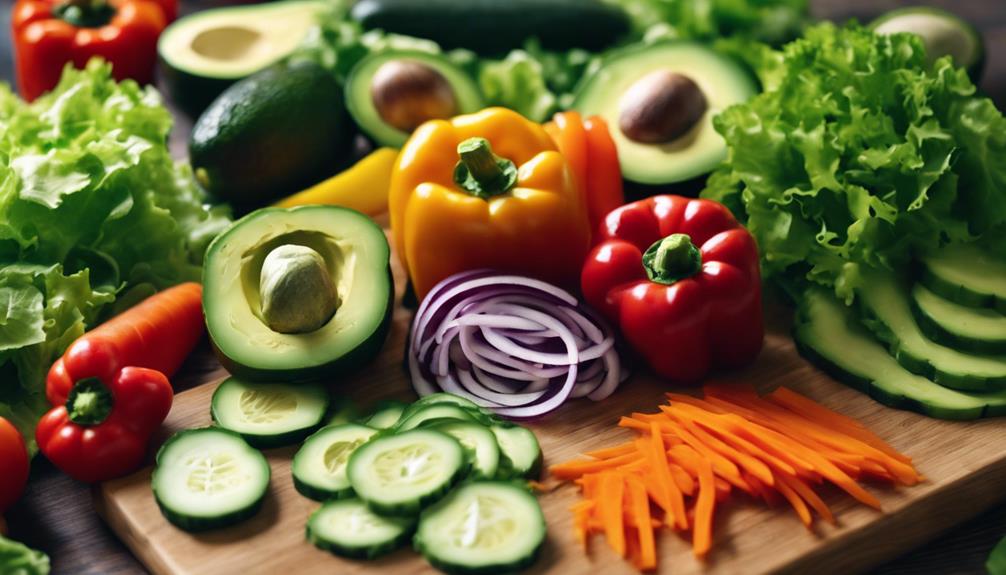
Consider incorporating a variety of colorful vegetables to add both visual appeal and diverse flavors to your lettuce wraps. Here are some serving suggestions to elevate your light and nutritious meal:
- Colorful Bell Peppers: Thinly slice red, yellow, and orange bell peppers to add a crunchy texture and vibrant colors to your Asian lettuce wraps.
- Crispy Carrot Strips: Julienne carrots into thin strips for a sweet and crunchy addition that complements the ground turkey mixture.
- Invigorating Cucumber Ribbons: Use a vegetable peeler to create long cucumber ribbons that provide a cool and invigorating contrast to the warm filling.
- Nutty Sesame Seeds: Sprinkle toasted sesame seeds on top of your lettuce wraps for a nutty flavor and a hint of crunch that enhances the overall dish.
Incorporating these colorful vegetables won't only enhance the visual appeal of your lettuce wraps but also introduce a variety of flavors that will make each bite a delightful experience.
Storing Leftover Lettuce Wraps
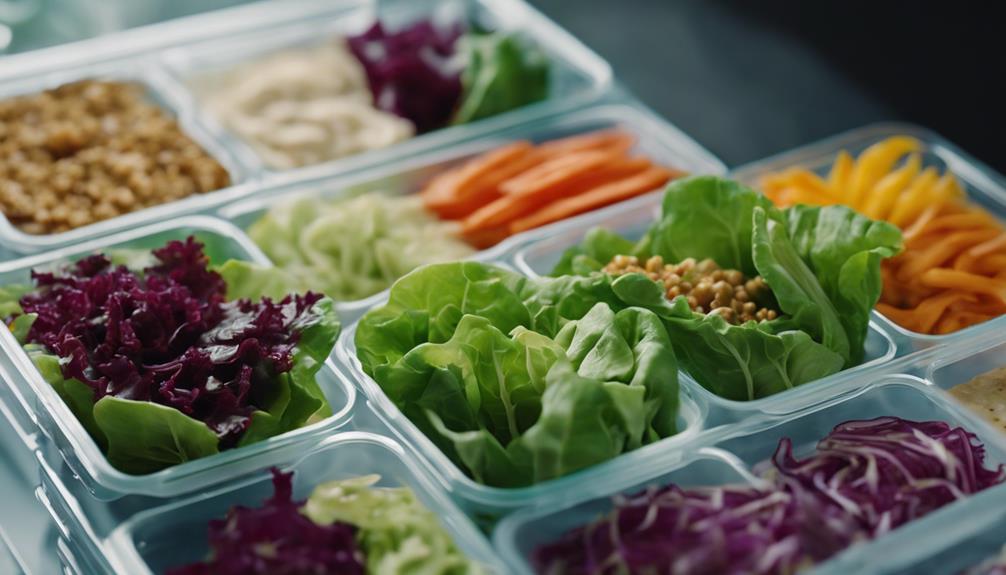
In guaranteeing the freshness of your lettuce wraps for future consumption, it's important to store them properly. When dealing with leftover lettuce wraps, place them in an airtight container to shield them from moisture and odors in the refrigerator.
For best results, store the turkey filling separately from the lettuce leaves to prevent sogginess. Remember to refrain from assembling the wraps in advance, as this can lead to a compromised texture.
Leftover lettuce wraps can be safely stored in the refrigerator for 3-4 days. If you wish to extend their shelf life, consider freezing the cooled turkey mixture in a freezer-safe container for up to 2 months. Before reheating and assembling fresh lettuce wraps, thaw the frozen turkey mixture in the refrigerator overnight.
Enhancing Flavor With Sriracha Sauce

Enhance the flavor of your turkey veggie lettuce wraps by adding a spicy and tangy kick with Sriracha sauce. Here are some ways to make the most of this flavorful condiment:
- Drizzle a moderate amount of Sriracha sauce over the turkey mixture before wrapping it in lettuce leaves. This will infuse the filling with a bold and zesty flavor.
- Mix Sriracha sauce into a light dressing or marinade for the turkey to add an extra layer of heat and complexity to the dish.
- Use Sriracha sauce as a dipping condiment for your lettuce wraps. Its spicy kick will complement the fresh crunch of the veggies and the savory turkey.
- Experiment with the amount of Sriracha sauce to find the right balance of heat and flavor that suits your palate. Remember, a little goes a long way, as Sriracha can pack quite a spicy punch.
Enjoy the fusion of flavors in your turkey veggie lettuce wraps with this versatile and fiery condiment.
Variations: Chicken or Beef Substitutes
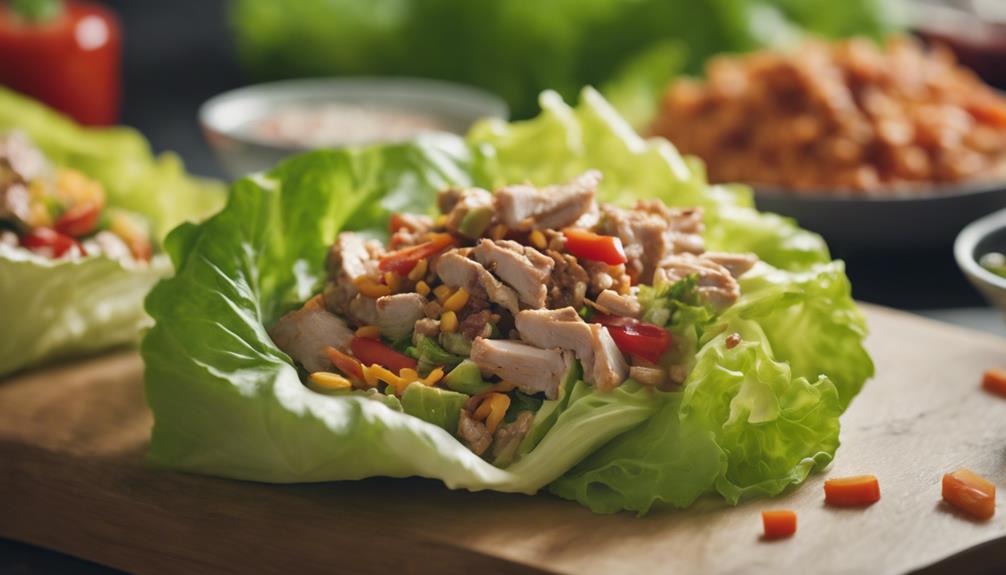
To switch up the protein in your turkey veggie lettuce wraps, easily swap out the ground turkey with either ground chicken or beef for a delicious alternative. Ground chicken serves as a lean and flavorful option, providing a similar texture to turkey.
When using ground beef, opt for a lean variety to keep the dish on the healthier side. Season the chicken or beef with low-sodium soy sauce, ground ginger, and a sprinkle of chili powder to infuse the wraps with a burst of invigorating flavors.
The butter lettuce leaves will cradle the seasoned protein and veggies, offering a rejuvenating crunch with every bite. Whether you choose ground chicken or beef, these substitutes offer a versatile twist to the classic turkey lettuce wraps, allowing you to tailor the dish to your preferences while maintaining a nutritious and satisfying meal.
Health Benefits of Butter Lettuce
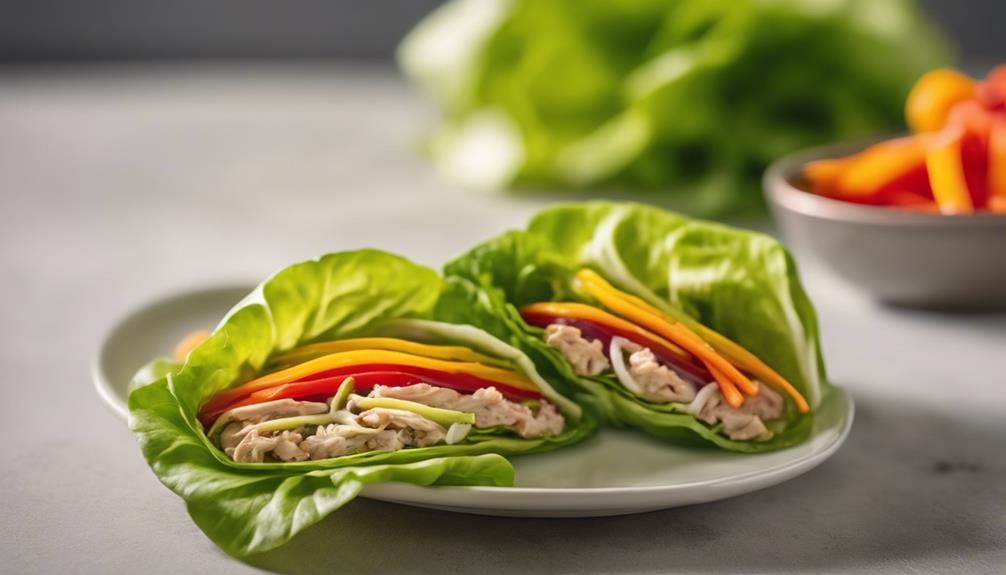
Effortlessly incorporating butter lettuce into your meals not only provides an invigorating crunch but also offers a range of health benefits that contribute to your overall well-being. Here are some reasons why adding butter lettuce to your diet is a smart choice:
- Nutrient-Rich: Butter lettuce is low in calories but high in essential nutrients like vitamin K, A, and folate, which are important for various bodily functions.
- Antioxidant Power: This lettuce variety contains antioxidants that help protect your cells from damage and reduce inflammation in the body, supporting overall health.
- Gut Health: With a good amount of fiber, butter lettuce aids in digestion and promotes a healthy gut environment, keeping your digestive system running smoothly.
- Hydration Boost: The high water content in butter lettuce helps keep you feeling full and contributes to overall hydration, making it a healthy choice for your meals.
Incorporating butter lettuce into dishes like lettuce wraps with ground turkey cooked in a skillet not only adds a healthy touch but also boosts the nutritional value of your meal.
Frequently Asked Questions
What Is the Nutritional Value of Turkey Lettuce Wraps?
You'll get a balanced meal with turkey lettuce wraps. Lean protein from turkey aids muscle growth. Fiber-rich veggies boost digestion. Low-carb option for keto fans. Colorful veggies bring vitamins and antioxidants to your plate.
Are Lettuce Wraps Healthy for Weight Loss?
You might be surprised! Lettuce wraps are a smart choice for weight loss. Packed with nutrients and low in calories, they help manage weight by replacing high-carb options. Customize with turkey and veggies for a satisfying meal.
Are Lettuce Wraps Healthier Than Bread?
Yes, lettuce wraps are healthier than bread. They offer lower calories and carbs, making them a smart choice if you're watching your intake. They're also gluten-free and can boost veggie consumption, packing in essential nutrients.
How Many Calories in a Turkey Tom Lettuce Wrap?
You'll find around 250-300 calories in a Turkey Tom lettuce wrap. It varies based on your turkey, veggies, and condiments. These wraps are a smart choice for a light and nutritious meal.
Can I Use Chicken Instead of Turkey in the Veggie Lettuce Wrap Recipe?
Yes, you can use chicken instead of turkey in the veggie lettuce wraps recipe. Simply substitute the ground turkey with ground chicken and follow the rest of the recipe as usual. The chicken lettuce wraps recipe will still be delicious and full of flavor.
Conclusion
Dig into these turkey veggie lettuce wraps for a light and nutritious meal that will leave you feeling satisfied and energized.
With fresh ingredients and a burst of flavors, this dish is perfect for a quick and healthy lunch or dinner option.
So gather your ingredients, whip up this tasty filling, and wrap it all up in crisp butter lettuce leaves for a delightful culinary experience that your taste buds will thank you for.
Enjoy!

